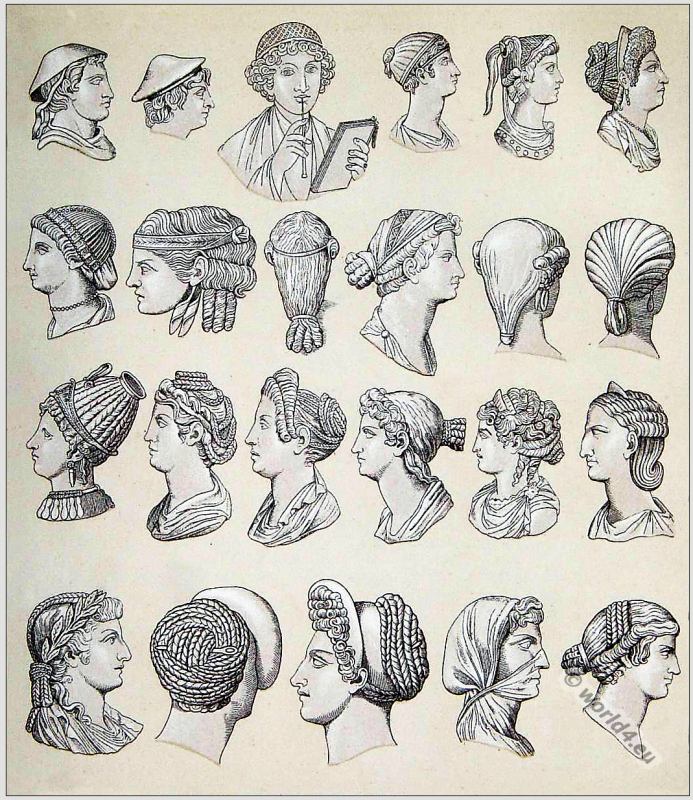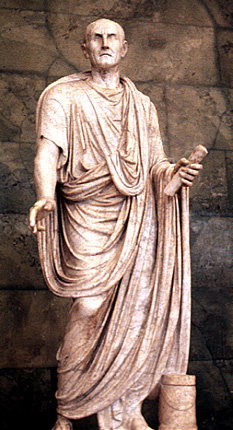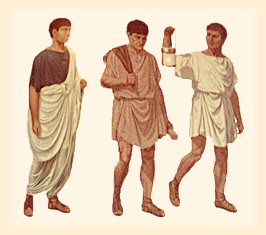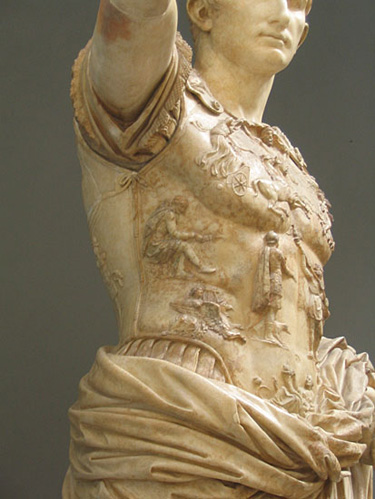|
Roman Costume
Until about 100 BC, Roman costume is hardly different from Greek costume of the same period except for the toga. Roman formality in the Republican periods reflected many of the Greek costume. There was the difference of the construction of the garments for the Greek chiton formed its sleeves from the top of the doubled rectangles, where the tunica and stola opened their sleeves at the sides for armholes.Men wore the toga, which was as sign of a distinguished Roman citizen. There were many different types of togas for different occasions, from the Toga pura, the ordinary dress of citizens, to the Toga trabea, a parti-colored toga with a purple border which would be a king's toga or a augur's toga. Men wore their hair closely clipped to the head with short locks falling on the forehead and neck. The men wore their face smooth-shaven and if they had a beard it would be one that was close clipped with mustache.
Women wore their hair much like Greek styles at first but as they period matured women wore their hair in elaborate coiffures. The women would frizz, intricately braid, coil, and pile false blond or red tresses in to grotesque designs. The would wear decorations and headdresses in their hair as well. The women would wear the stola, which was once called the Greek chiton, most of the days. If a woman who had shamed her honorable estate was deprived the right to wear the stola she would wear the make toga as a sign of her degradation.
There was more cream and white in the Roman times than in the Greek scene because togas were usually white. Rich people would wear purple because it was an expensive dye. Men would have wore blue and crimson too. Important men would wear red shoes. Women would have larger range of colors like scarlet, violet, marigold yellow, crocus yellow, hyacinth-purple, sea-green and blue. The colors were almost pastel but a little stronger. If a women were to marry she would wear flame and white.
Notable Roman Costuming Elements
| Toga—Outer garment, which was the badge of the Roman citizen, rich or poor. Originally the rectangular Greek pallium made into a ellipse, the draping of which developed infinite complications. Of wool, it was characteristically in bleached white. | ||||||||||||||||||
| Tunica—Wide, shirt-like, undergarment, the indoor dress of the Roman; worn outdoors without the toga only by working people. It was not, like the toga, distinctly Roman. Originally sleeveless and woolen, usually white, it acquired sleeves and was later made of linen and cotton as well. The tunic was girded with meticulous care to the exact length considered correct for the rank and the sex of the wearer. | ||||||||||||||||||
| Sinus—The fold of the toga that can be put over the head like a hood. | ||||||||||||||||||
| Umbo—Toga fold on the front of the garment that forms a pocket at the bottom of he sinus. | ||||||||||||||||||
| Paludentum—A purely military mantle, used as the official military mantle of the general in command, or the emperor while in the field. Used particularly in the earlier years, before the first century AD. In cut, it resembled the chalmys or lacerna with two corners truncated to form an elongated, primitive semicircle. | ||||||||||||||||||
| Clavi—Colored bands on the tunica, indicating the wearer's rank. With time the clavus lost distinction, and the by the first century it was worn by every one. The clavi then became more elaborately decorative in character, broke into spots of decoration, and amalgamated with borders at the hem of the garment. Augustus clavus: For equestrian knights: a narrow band running up over each shoulder and down to hem on tunic or ungirded dalmatica. Laus clavus: Single, wide clavus worn by senators. | ||||||||||||||||||
| Stola—Woman's garment. Worn over the tunica intima (which was of similar cut, might or might not have sleeves, and which served as a housedress.) The stola had sleeves like the men's tunica, or was pinned along the shoulder line and down the arms. It was girded once under the breast and often girdled again at the hips. | ||||||||||||||||||
| Lorica - This was a cuirass of brass or bronze, molded to the shape of the body with perfect fit and following the line of the abdomen. Frequently enriched with relief and ornaments in metal work. | ||||||||||||||||||
| Solea - Shoe-like sandal |   | |||||||||||||||||












No comments:
Post a Comment